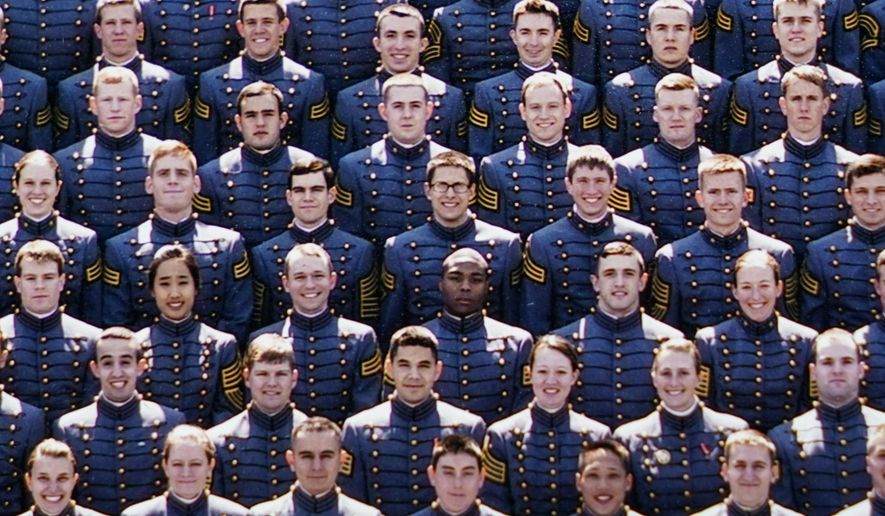Even the elite aren’t immune to the challenges of a pandemic and a red-hot job market.
The numbers of applications to freshmen classes at West Point and Annapolis were down sharply this year as the prestigious service academies struggle with the same recruiting crisis hobbling the rest of the U.S. military.
The Air Force Academy said it received 8,393 applications for the class of 2026, down from 11,599 for the class of 2025. Officials blame decisions made during the COVID-19 pandemic as the main culprit for the 28% drop.
“The Academy believes the cancellation of in-person recruiting and information events across the nation and at the Academy during the height of the pandemic, while a prudent health and safety concern, impacted the overall number of applications for the Class of 2026,” Col. Arthur Primas Jr., the Air Force Academy’s admissions director, said in a statement to The Washington Times.
Officials at the U.S. Military Academy also point the finger at COVID-19 for a drop in the number of applicants for West Point. They received 12,589 applications for the class of 2026, the current freshman class, 10% down from 13,984 for 2025.
“The downturn in applications is more of a result of pandemic issues associated with higher education across the board and an increase in taking a ‘gap year’ amongst high school graduates,” West Point officials said.
Still, the number of applicants for the class of 2026 was up from 12,294 for the class of 2022 and 11,674 for the class of 2023. West Point officials said they weren’t concerned about what they called a “nominal drop-off” in applications.
“Although we did have a recent decrease in overall applications, the quality still remains strong,” officials said.
The U.S. Naval Academy didn’t respond to questions about the number of applications for its class of 2026 but told Military.com that it had a 20% decrease from 16,265 who applied for the class of 2025. Annapolis officials joined the other service academies in blaming COVID-19 restrictions that prevented potential midshipmen from visiting the campus.
“Due to our unique mission, the Naval Academy relies heavily on in-person outreach, whether hosting potential candidates at the Naval Academy or our many in-person outreach events across the nation,” a spokesperson told Military.com.
Air Force Academy officials said they may have turned a corner with the gradual easing of COVID-19 restrictions across the country.
“With the return of in-person recruiting and information events, as of August 30, we are already up 29%, nearly 1,600 applications, from this point last year,” Col. Primas said. “In addition to our vast online resources, in-person communications and Academy visits are the time-proven key to generating robust awareness, interest, and completed applications from young people.”
The number of young Americans interested in the military has dropped while Republican and Democratic administrations have expanded operations across the board.
Washington’s growing demands mean longer deployments and fewer units required to cover larger territories.
A bigger problem
Although service academy officials say their declines in applications are temporary, the issue is more complicated for filling the enlisted ranks.
Secretary of the Army Christine E. Wormuth and Gen. James C. McConville, the Army chief of staff, released a joint memo in July acknowledging that the U.S. military was facing the most challenging recruitment environment since the draft was abolished in 1973. They said only 23% of 17- to 24-year-old potential recruits are even qualified to serve in the military.
“Pandemic-driven constraints like virtual learning have further limited access to the recruiting population in high schools and exacerbated a decline in academic and physical fitness levels,” the memo said.
Remote schooling may have lowered the scores for the Armed Services Vocational Aptitude Battery, the test recruits take before entering the military, by as much as 9%, Army officials said.
“These conditions have negatively affected the Army’s ability to meet its recruiting targets,” the memo said.
The military historically has an easier time meeting recruiting targets when the private sector offers fewer alternatives for young people. Recruiters this year are facing a U.S. unemployment rate of just 3.7% and reports of employers raising pay and offering hiring bonuses to attract entry-level workers.
Stars and Stripes reported last month that the Army, which traditionally has had the hardest time filling its large manpower needs, is expected to reach barely over 50% of its recruiting target for the year.
“It’s just really hard to recruit people right now,” Jeff Wenger, a senior policy researcher on recruitment issues with the Rand Corp., told the military publication. “We’re really in uncharted territory here. … It’s hard to make predictions in this market as to what a return to normalcy will be.”
The Ronald Reagan Presidential Foundation & Institute released a survey last year that revealed a decline in trust and confidence in the U.S. military and uncertainty about whether America should lead in the world.
The Reagan National Defense Survey indicated a growing sense of pessimism in the country, with 59% of respondents saying the country is heading in the wrong direction.
The number of Americans who say they have a “great deal” of trust and confidence in the military fell from 70% to 45% in the past three years, according to the survey.
“Perhaps most troubling for recruitment in the all-volunteer force, only one-third of adults under the age of 30 have high confidence in the military, which is down 20 points since 2018,” according to the survey.
For more information, visit The Washington Times COVID-19 resource page.
• Mike Glenn can be reached at mglenn@washingtontimes.com.




Please read our comment policy before commenting.